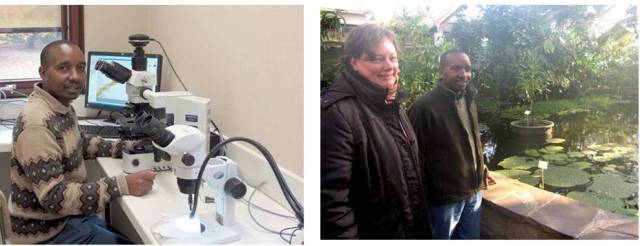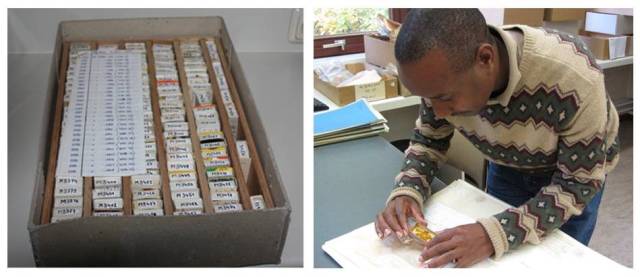 NDIRITU George Gatere, Kenya
NDIRITU George Gatere, Kenya
Abstract
Myxomycetes are a small-sized monophyletic group of eukaryotic organisms with 850 to 890 species. They constitute an important component of the decomposition and nutrient cycling in terrestrial ecosystems. Though myxomycetes studies and reports in the African continent are scarce, there are substantial collections of myxomycetes obtained in the continent since 1867 which are scattered in several herbaria across Europe. A significant part of them are housed in the National Botanic Garden of Belgium. This project intends to: (i) make inquiries and visits to institutions where these collections are stored, (ii) compile data from these collections and identify them if they have not yet been verified, (iii) prepare and compose checklists of various ecosystems or countries, and (iv) update the African myxomycetes checklist on the web (http://www.mycotaxon.com/resources/checklists/ndiritu_v107-checklist.pdf). With these data an overall view of the distribution of myxomycetes of the African continent can be established and information gaps identified.
Training location: National Botanic Garden of Belgium, Meise
Aim
The overall aim of this project is to increase the amount of information available on myxomycetes of the African continent. Myxomycetes collected in the past in Africa are housed for the largest part in the herbarium of the National Botanic Garden of Belgium (NBGB) and to a lesser extent in the herbarium of Ghent University (UG). More precisely this project intends to: (i) make inquiries and visits to institutions where myxomycetes collections could be stored, (ii) compile data from these collections and identify them if they are not yet verified, (iii) gather data from previous publications on African myxomycetes, (iv) prepare and compose checklists of various ecosystems or countries, and (v) update the African myxomycetes checklist (http://www.mycotaxon.com/resources/checklists/ndiritu_v107-checklist.pdf).
Project description
Studies of myxomycetes in Africa are scarce. As such our knowledge on the diversity, distribution and ecology of myxomycetes is still at infancy level. There are an extremely low number of myxomycetes systematists (taxonomists) active in Africa. This is reflected by the few myxomycetes known from Africa (only 294 species), which is low when compared with other regions in the world. Since 1867 several biodiversity expeditions have been carried out in Africa, particularly in the tropical rainforests mainly by naturalists from Europe and USA. Some of the specimens collected were myxomycetes. For various reasons some of these collections were not identified and a number of those that were identified are not yet reported. A significant percentage of these are stored at the NBGB and UG. Most of these collections were compiled by renowned naturalists including O.F. Cook (1867-1949), N.E. Nannenga-Bremekamp (1916-1996) and J. Rammeloo, the former director of the NBGB. The herbaria of the NBGB and UG hold about 1000 specimens and represent at least 145 species, most of which have not been reported. This project seeks to search, sort, compile and identify them; and later use this data to update the current African myxomycetes checklist on the web (http://www.mycotaxon.com/resources/checklists/ndiritu_v107-checklist.pdf).

Dr Ndiritu working at the lab at the NBG (left) and with his tutor, Ms. Myriam de Haan, in the greenhouse of the NBG (right).

Collections from Africa in labeled boxes (left), Dr Ndiritu examining a collection at NBGB (right).

